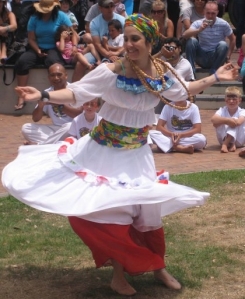About Brazilian Dances
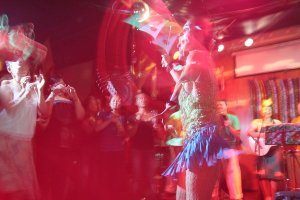
Dance is a form of non-verbal communication for expressing human experiences, which in the course of time has developed into a form of art. Brazil is a land of many popular dances that contain the elements of African, Portuguese and European dance forms. Samba, Carimbo, Capoeira, Forro, Coco, Cacuria, Jongo,Lundu and other dances are some of the famous dances of Brazil. Here is an account of the origin and evolution of these dances.
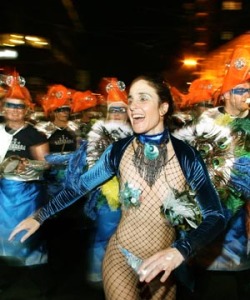 Samba is what immediately comes to mind at the very mention of Brazilian dance. Some believe that samba was derived from the word ‘semba’, which signifies a navel bump in Kimbundo, the African Bantu language, and symbolizes the invitation to dance from a man to a woman. ‘Semba’ is also an infinitive of ‘kusamba’, which means ‘to pray’, or to appeal for the favor of the Gods or ancestors by singing and dancing. So, the dance was an indispensable part of the religious ceremonies.
Samba is what immediately comes to mind at the very mention of Brazilian dance. Some believe that samba was derived from the word ‘semba’, which signifies a navel bump in Kimbundo, the African Bantu language, and symbolizes the invitation to dance from a man to a woman. ‘Semba’ is also an infinitive of ‘kusamba’, which means ‘to pray’, or to appeal for the favor of the Gods or ancestors by singing and dancing. So, the dance was an indispensable part of the religious ceremonies.
Brazil was a colony of the Portuguese during the period 1500 to 1822, and the Portuguese rulers, mainly brought African slaves, to Brazil from Angola. When the African slaves reached Brazil, they were converted into Christians, and prevented from worshiping their traditional gods by the Portuguese government. They continued to carry out religious practices in the guise of parties. But, soon, they came under the suspicion of the authority, as a result of which, the police often raided such parties. Eventually, they tried to preserve the secret rhythms of samba by combining them with other musical forma, which over a period of time gave birth to a series of dances and music genres.
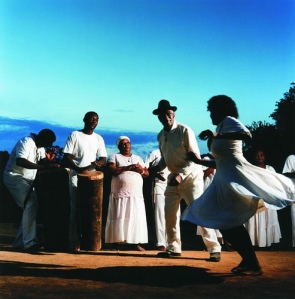 Jongo is an essentially rural cultural manifestation directly associated with the African culture in Brazil. The formation of samba carioca was heavily influenced by Jongo. Inserting itself within the so-called ‘dances of the belly strike’ (however being related to the ‘Semba’ or ‘Masemba’ of Angola), the Jongo was brought to Brazil by Bantus. Generally, these Bantus were kidnapped in the ancient kingdoms of Ndongo and Kongo, which nowadays makes up most of the region of Angola. Composed through characteristics of music and dance and animated by improvisational poets, the Jongo most likely has its origins in the traditional Angolan guessing games, the Jinongonongo. One essential characteristic of the Jongo is the utilization of symbols that, aside from maintaining rhythm, possess a magical function, apparently provoking paranormal phenomenon. Among the more evident ones, one can cite the fire, with which the instruments are tuned; the drums, that are considered to be ancestors of the community’ the circular form of the dance with a couple in the middle, which refers to fertility; and not to forget, the rich metaphors used by the jongueiros (participants of the Jongo) in order to compose its main points and whose meaning is inaccessible to those not yet initiated.
Jongo is an essentially rural cultural manifestation directly associated with the African culture in Brazil. The formation of samba carioca was heavily influenced by Jongo. Inserting itself within the so-called ‘dances of the belly strike’ (however being related to the ‘Semba’ or ‘Masemba’ of Angola), the Jongo was brought to Brazil by Bantus. Generally, these Bantus were kidnapped in the ancient kingdoms of Ndongo and Kongo, which nowadays makes up most of the region of Angola. Composed through characteristics of music and dance and animated by improvisational poets, the Jongo most likely has its origins in the traditional Angolan guessing games, the Jinongonongo. One essential characteristic of the Jongo is the utilization of symbols that, aside from maintaining rhythm, possess a magical function, apparently provoking paranormal phenomenon. Among the more evident ones, one can cite the fire, with which the instruments are tuned; the drums, that are considered to be ancestors of the community’ the circular form of the dance with a couple in the middle, which refers to fertility; and not to forget, the rich metaphors used by the jongueiros (participants of the Jongo) in order to compose its main points and whose meaning is inaccessible to those not yet initiated.
These days, both men and women can participate in the Jongo, but this participation in its original form was very restricted to the initiated or the more experienced members. This factor relates itself to the ethical and social norms commonly found in other traditional societies, such as the Amerindians. The basis is a respect and obedience towards the older individuals and the ancestral past. Historical research indicates that the Jongo possesses, within its Bantu origins, the need to create diverse communities, similar to secret societies and political-religious sects. These fraternities had an important role in the resistance of slavery, as a means of communication, organization and even the purchase of liberated slaves. The Jongo is made up of singing and dancing, with the accompaniment of the urucungo (a musical Bantu arc, that gave way to the berimbau), the violin and pandeiro, in addition to the consecrated drums, used even today, called Tambu or Caxambu. The Jongo is still widely practiced today in various cities: The Vale do Paraíba in the Southeast region of Brazil, to the South of the state of Rio de Janeiro and to the North of São Paulo.
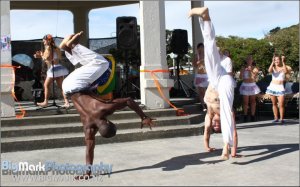 Capoeira is another important Afro-Brazilian dance, and believed to have evolved from martial arts. It was also created in Brazil by African slaves, mainly from Angola. However, there are lots of controversies regarding the origin of this dance. Some historians are of the opinion that it directly evolved from the African fighting style; while others think that it is a Brazilian dance having both Brazilian and African influences. Some experts suggested that the word ‘capoeira’ was derived from the word ‘capao’, which is a Portuguese word for castrated rooster. The dancing style is also similar to a fight between two roosters. Kongo K. Kia Bunseki Fu-Kiau also suggested that capoeira could have got its name from the kikongo word ‘kipura’, that describes the movement of a rooster while fighting. Though there are considerable differences of opinion regarding the origin of the dance and its name, it is an undeniable fact that the dance steps have close similarity with martial arts, as a lot of fighting movements like kicks, sweeps, punches and elbow strikes can be seen in this dance. The participants usually form a circle and then take turns in pairs in playing a musical instrument or singing or performing fighting acts in the center.
Capoeira is another important Afro-Brazilian dance, and believed to have evolved from martial arts. It was also created in Brazil by African slaves, mainly from Angola. However, there are lots of controversies regarding the origin of this dance. Some historians are of the opinion that it directly evolved from the African fighting style; while others think that it is a Brazilian dance having both Brazilian and African influences. Some experts suggested that the word ‘capoeira’ was derived from the word ‘capao’, which is a Portuguese word for castrated rooster. The dancing style is also similar to a fight between two roosters. Kongo K. Kia Bunseki Fu-Kiau also suggested that capoeira could have got its name from the kikongo word ‘kipura’, that describes the movement of a rooster while fighting. Though there are considerable differences of opinion regarding the origin of the dance and its name, it is an undeniable fact that the dance steps have close similarity with martial arts, as a lot of fighting movements like kicks, sweeps, punches and elbow strikes can be seen in this dance. The participants usually form a circle and then take turns in pairs in playing a musical instrument or singing or performing fighting acts in the center.
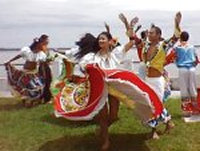 Carimbo
is the name of both the dance and the large drums that accompany it. In Tupi language, it means the drum. Carimbo is a folk dance of the Para state in Brazil, in which African, Portuguese and European influence can be noticed. It is a sensual dance, where the woman tries to cover the man with her skirt. Sometimes, the woman throws her handkerchief on the floor, which her male partner has to retrieve by using his mouth. With the influence of more modern rhythms, carimbo contributed to the development of another dance form ‘Lambada’. In Portuguese, lambada means ‘strong slap’ or ‘hit’. It may refer to the wave-like motion of a ship in Brazilian Portuguese language. The dance is also characterized by wave-like body movements of the dancers and became popular throughout the world in 1980s.
Carimbo
is the name of both the dance and the large drums that accompany it. In Tupi language, it means the drum. Carimbo is a folk dance of the Para state in Brazil, in which African, Portuguese and European influence can be noticed. It is a sensual dance, where the woman tries to cover the man with her skirt. Sometimes, the woman throws her handkerchief on the floor, which her male partner has to retrieve by using his mouth. With the influence of more modern rhythms, carimbo contributed to the development of another dance form ‘Lambada’. In Portuguese, lambada means ‘strong slap’ or ‘hit’. It may refer to the wave-like motion of a ship in Brazilian Portuguese language. The dance is also characterized by wave-like body movements of the dancers and became popular throughout the world in 1980s.
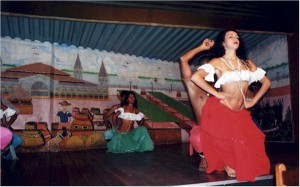 Lundu is also a dance form brought by the African slaves, and it became very popular in Brazil during the seventeenth and early eighteenth centuries. The basic musical instruments involved are guitar, piano and drum. This dance also involves the use of handkerchief and castanets, an instrument consisting of a pair of hollow pieces of wood, or bone, and is held between the thumb and the fingers.
Lundu is also a dance form brought by the African slaves, and it became very popular in Brazil during the seventeenth and early eighteenth centuries. The basic musical instruments involved are guitar, piano and drum. This dance also involves the use of handkerchief and castanets, an instrument consisting of a pair of hollow pieces of wood, or bone, and is held between the thumb and the fingers.
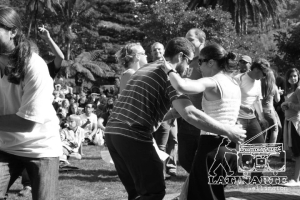 Forro derived from the word forrobodo, means ‘great party’. However, there is another theory that suggests that forro is the derivative of the English ‘for all’. It is one of the most popular dances of Northeastern Brazil and can be danced to the rhythm of different music genres. The instruments used in this dance are accordion, zabumba and a metal triangle. A lot of variation can be observed in the dancing style of forro in different regions of Brazil. It is danced with partners and the participants move in proper synchronization, performing many complex steps.Nowadays, Brazilian dances have received immense popularity throughout the world. Most of these dances have evolved through ages by embracing the African, Portuguese and European dancing traditions, and now they have become an indispensable part of Brazilian culture and tradition. Forro is also the rhythms:
Forro derived from the word forrobodo, means ‘great party’. However, there is another theory that suggests that forro is the derivative of the English ‘for all’. It is one of the most popular dances of Northeastern Brazil and can be danced to the rhythm of different music genres. The instruments used in this dance are accordion, zabumba and a metal triangle. A lot of variation can be observed in the dancing style of forro in different regions of Brazil. It is danced with partners and the participants move in proper synchronization, performing many complex steps.Nowadays, Brazilian dances have received immense popularity throughout the world. Most of these dances have evolved through ages by embracing the African, Portuguese and European dancing traditions, and now they have become an indispensable part of Brazilian culture and tradition. Forro is also the rhythms:
–Baião: oftentimes referred to as “baion”, is a rhythm from the state of Bahia in Northeastern Brasil. Most people credit Luis Gonzaga with popularizing this rhythm. The baião is a rhythm that although is not very well known outside Brazil, has enormous influence over much of modern Brazilian music. The traditional instrumental baião is a musical form based on an ancient figure dance or ballroom dance of European origin. We can use Ceará, a Northeastern state in Brazil, as point of reference for the origin of this form, although it developed through most of the Northeast. In the Northeast region of Brazil this form was played by local bands that performed in salons and in private parties and at different celebrations. The original instrumentation of these was one or two lead pífanos, -small hand-carved bamboo flutes- a zabumba -a large bass drum-, and other minor percussion instruments. This instrumentation became standard in the performance of traditional instrumental baião, for which these bands got to be known as “Bandas de Pífanos.” The rhythmic pattern is defined by the zabumba drum. The zabumba has skin on both sides. It is played with a mallet on one side to produce an open bass tone, and with a stick on the other side to produce a higher pitched sound. The stick is played on the rim. The result is a syncopated 2-4 rhythm. The traditional baião melodies are based on a Lydian flat 7th scale, a scale derived from the tuning of the pífano flute, which has a raised 4th and flattened 7th. The chord structure is based on a Dominant 7th chord. In the 1930s and 1940s, tunes like “O Baião” by Luiz Gonzaga made these chords a standard in baião music.
–Xote is a Brazilian music genre and dance for pairs or groups of four. It is the local equivalent of the German schottische. Xote is a common type of forró dancing. The word xote is a corruption of the German word schotisch meaning Scottish; the schottische is related to the Scottish polka. The schottische was brought to Brazil by José Maria Toussaint in 1851 and it was a dance popular among the upper classes during the reign of Emperor Pedro II. Later, African slaves danced their own adaptations of the dance, adding their own influences, converting it into a dance that was more popular and well known. This period was when the style came to be known as xote or xótis. The xote is a very versatile dance and has a number of local versions, such as the southern version called xote gaúcho.
– Xaxado is a popular dance created in the Sertão of Pernambuco state, Brazil. It was often practiced by cangaceiros of the region to commemorate victory in battle; it is also practiced as a traditional dance by the local population as a whole.The name xaxado comes from the noise made by the cangaceiros’ sandals as they strike the sand during the dance.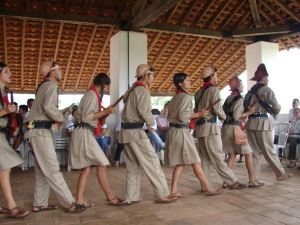
Batuque is the circle dance where Africans showed their culture – was the main trunk with respect to the formation of popular music Brazil with all its diversity and variations that have sprung up in urban and rural areas, under various names and styles themselves.
Samba Partido Alto old samba Second, the words “loud party”comes from the high dignity of samba. Genre samba very close to African drumming, and cultivated in the city of Rio de Janeiro since the end ocentury. XIX by groups of blacks already urbanized. It umbigada dance with marked rhythm by clapping, kitchen dish scraped with a knife, rattle and percussion instruments, and sometimes accompanied by guitar and the cavaquinho.
Samba de roda (“Samba of roda”) is a traditional Afro-Brazilian dance performed originally as informal fun after a Candomblé ceremony, using the same percussion instruments used during the religious ceremony. The typical drum is the atabaque; drummers improvise variations and elaborations on common patterns, accompanied typically by singing and clapping as well as dancing.
The Samba de Roda is a celebratory event incorporating music, choreography and poetry.
The term ‘Samba’ encompassed many different rhythms, tunes, drumming and dances of various periods and areas of the Brazilian territory. It appeared in the state of Bahia, more specifically in the region of Recôncavo in Brazil, during the 17th century.
Because all drumming and dance was generalized by Portuguese colonizers as ‘samba’, it is difficult to attribute it to one distinct heritage. However, the most universally recognized cultural origin of Samba is Lundu, a rhythm that was brought to Brazil by the Bantu slaves from Africa. Lundu reveals, in a way, the amalgamation of black (slaves) and white (Portuguese) and indigenous cultures. When the African slaves where imported, it was named the “semba” and with the introduction of the Arabic Pandeiro (tambourine), brought into the Roda by the Portuguese, the ‘Samba’ was molded into the form of dance it is now.
In the indigenous language, “samba” means roda de dança, or a circle to dance since the indigenous peoples danced in celebration on many occasions, such as the celebration of popular Catholic festivals, Amerindian or Afro-Brazilian religious ceremonies, but was also practiced at random.
All participants, including beginners, are invited to join the dance and observe as well as imitate. Usually, only the women dance after each other and they are surrounded by others dancing in a circle and clapping their hands. The choreography is often spontaneous and is based on movements of the feet, legs and hips. One of the most typical moves is the umbigada which is clear Bantu influence, where the dancer invites her successor into the circle’s center.
The factor that frequently draws the attention of most people to the rhythm is the unusually-accented (syncopated) beat. The absent beat is the strongest characteristic of Samba prompting the listener to dance to fill the gap with her/his body movements. This syncopated rhythm is also an indication of Black resistance against cultural assimilation. The Samba of Roda in particular was considered an expression of freedom and identity of the underprivileged and became a means of liberation.
The Samba de Roda has significantly waned during the twentieth century due to economic decline and increased poverty in the region. The effects of mass media and competition from popular modern music have also devalued this tradition among the younger generation. Finally, the weakening of the Samba de Roda was heightened through the aging of practitioners and demise of those who made the musical instruments.
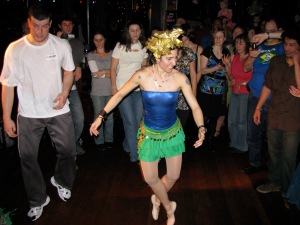 Frevo: the word Frevo, derived from frever (boil) refers to the carnival and street dance hall, essentially rhythmic, in duple and progress faster than marching from Rio, and in which the dancers (dancers) perform individual choreography, improvisation and frenetic. It’s a Brazilian dance, originating in the Northeast.
Frevo: the word Frevo, derived from frever (boil) refers to the carnival and street dance hall, essentially rhythmic, in duple and progress faster than marching from Rio, and in which the dancers (dancers) perform individual choreography, improvisation and frenetic. It’s a Brazilian dance, originating in the Northeast.
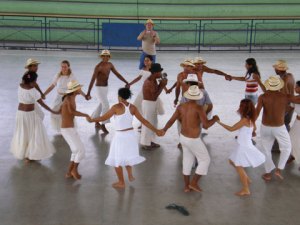 Coco: folk dance wheel northern and northeastern Brazil, originating Alagoas, accompanied by singing and percussion. Believed to have been born beaches, hence its name. The pace has undergone several changes with the appearance of the caatingas baião and harsh. As a composer who popularized the rhythm can cite Jackson do Pandeiro.
Coco: folk dance wheel northern and northeastern Brazil, originating Alagoas, accompanied by singing and percussion. Believed to have been born beaches, hence its name. The pace has undergone several changes with the appearance of the caatingas baião and harsh. As a composer who popularized the rhythm can cite Jackson do Pandeiro.
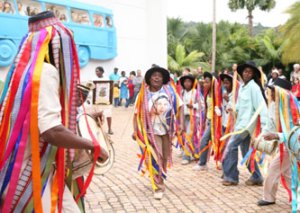 Congado: dramatic ballet in which the participants represent, including corners and dances, the crowning of a king of Congo.
Congado: dramatic ballet in which the participants represent, including corners and dances, the crowning of a king of Congo.
Mozambique: Ballet warrior of black origin, no plot, the sound of percussion instruments, like the dances of fighting congadas, and in which the rhythm is marked by clashes of bats. Common in Brazilian states of Minas Gerais, Goias and Sao Paulo.
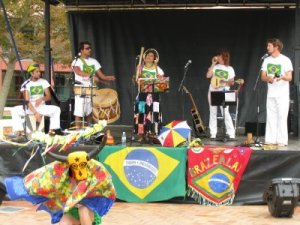 Bumba Meu Boi is a Brazilian folk theatrical tradition – the tale told through the music, the costumes and drumming involves a Bull, which dies and is brought back to life. The actual tale told varies, but central characters include the Bull (a player in an elaborate costume), Catirina (an ugly pregnant girl – usually played by a man in drag), a cowboy who is in charge of the Bull and who causes the Bull to die, the priest, the rich and powerful owner of the bull, and the music (which magically Drums the Bull back to life).Festivals where groups all tell their versions of the Bumba Meu Boi tale can be found throughout Brazil. Bumba Meu Boi (“Hit My Bull”) or Boi Bumbá is a popular regional festival which takes place annually in North and Northeast Brazil although celebrations can be found throughout the country.
Bumba Meu Boi is a Brazilian folk theatrical tradition – the tale told through the music, the costumes and drumming involves a Bull, which dies and is brought back to life. The actual tale told varies, but central characters include the Bull (a player in an elaborate costume), Catirina (an ugly pregnant girl – usually played by a man in drag), a cowboy who is in charge of the Bull and who causes the Bull to die, the priest, the rich and powerful owner of the bull, and the music (which magically Drums the Bull back to life).Festivals where groups all tell their versions of the Bumba Meu Boi tale can be found throughout Brazil. Bumba Meu Boi (“Hit My Bull”) or Boi Bumbá is a popular regional festival which takes place annually in North and Northeast Brazil although celebrations can be found throughout the country.
Ciranda is a type of dance and music from Pernambuco . It originated in the region northeast more precisely in Itamaraca , the fishermen’s wives who sang and danced hoping they reach the sea. It is characterized by the formation of a large circle, usually on the beaches and parks, where members dance to the sound of slow and repeated.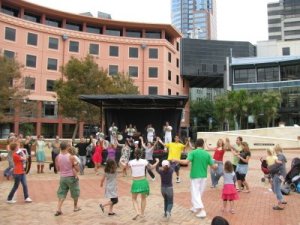
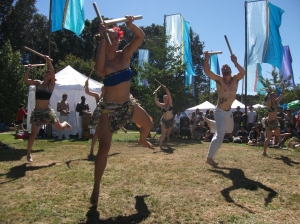 Maculele is an Afro Brazilian dance where a number of people gather in a circle called a Roda,In the roda, one or more Atabaques positioned at the entrance of the circle. Each person brandishes a pair of long sticks, traditionally made from Biriba wood from Brazil. The sticks, called grimas, traditionally measure 24 inches long by 1 and 1/8 inch thick.. They are substantially similar to Eskrima sticks. As the Maculelê rhythm plays on the atabaque, the people in the circle begin rhythmically striking the sticks together. The leader sings, and the people in the circle respond by singing the chorus of the songs. When the leader gives the signal to begin playing Maculelê, two people enter the circle, and to the rhythm of the atabaque, they begin striking their own and each other’s sticks together. On the first three beats, they strike their own sticks together, making expressive and athletic dance movements, and on each fourth beat, they strike each other’s respective right-hand stick together. This makes for a dance that looks like “mock stick combat”. (Also, traditionally in Maculelê, the players wear dried grass skirts).
Maculele is an Afro Brazilian dance where a number of people gather in a circle called a Roda,In the roda, one or more Atabaques positioned at the entrance of the circle. Each person brandishes a pair of long sticks, traditionally made from Biriba wood from Brazil. The sticks, called grimas, traditionally measure 24 inches long by 1 and 1/8 inch thick.. They are substantially similar to Eskrima sticks. As the Maculelê rhythm plays on the atabaque, the people in the circle begin rhythmically striking the sticks together. The leader sings, and the people in the circle respond by singing the chorus of the songs. When the leader gives the signal to begin playing Maculelê, two people enter the circle, and to the rhythm of the atabaque, they begin striking their own and each other’s sticks together. On the first three beats, they strike their own sticks together, making expressive and athletic dance movements, and on each fourth beat, they strike each other’s respective right-hand stick together. This makes for a dance that looks like “mock stick combat”. (Also, traditionally in Maculelê, the players wear dried grass skirts).
Puxada de Rede is a Brazilian Folkloric theatrical play seen in many Capoeira performances. It is based on a traditional Brazilian story of A fisherman goes out to fish at night on a Jangada, a handmade seaworthy sailing raft used by fishermen of north-eastern Brazil. His wife has a presentiment of something wrong and tries to stop him from going fishing that night. He goes anyway, leaving his wife crying and his kids scared. His wife waits the whole night for him on the beach, and around 5:00am, the usual arrival time, she sees the jangada. The fishermen have a very sad expression and some are even crying, but she does not see her husband. The fishermen tell her that her husband has fallen off the jangada by accident. As they start to withdraw the net, they find his body amongst the fish. His friends carry his body on their arms, in a traditional funeral ritual on the beach.
Lectures Given at Victoria University and Embassy of Brazil in Wellington NZ:
https://rapidshare.com/files/3474045388/Capoeiralecture.ppt
https://rapidshare.com/files/4027465328/Carnival.ppt
ZambaBem Podcast
1)Samba Class
https://rapidshare.com/files/143484659/Aula_de_Samba.m4a
2)Brazealand Band
https://rapidshare.com/files/3011230424/Brazealand_Band_Podcast.m4a
3)Forro Class
https://rapidshare.com/files/45795744/Meus_forros_favoritos.m4a
Festas juninas were brought to Brazil by Portuguese and Spanish settlers celebrating the harvest and their favorite saints. The cool June weather calls for bonfires, lots of dancing, rich food and alcohol.
June is a lively month in Brazil. If you live here or are passing by you will be invited to a festa junina, where you will eat Brazilian sweets and drink quentão, a warm drink made with pinga or vinho quente, a warm spicy wine. Children dress up like country bumpkins, play typical games and win prizes.
One of the highlights of a festa junina is a quadrilha, which is a type of square dance with sometimes over twenty participants. A “couple” getting married leads the other couples in the quadrilha. Their wedding ceremony is only one part of a complex dance. The groom always runs away and is often brought back by an angry father of the bride. It is quite a spectacle. Sometimes, the participants even switch roles, the girls dressed up as boys and the boys as girls. This makes the quadrilha even funnier. The cool June weather calls for bonfires. Colorful flags are strung up and paper hot-air balloons are released into the sky. The fun continues on into the night. Where did this idea come from? Why is it a part of Brazilian culture? Portuguese and Spanish settlers celebrating the harvest and worshipping saints brought these parties to Brazil.
Although it has become a commercialized party, the traditional festa junina is still celebrated in the Northeast and in rural communities, where Catholic people commemorate their favorite saints. These saints’ statues are hoisted onto shoulders and paraded through town on their special day. Three saints are commemorated in June: Santo Antônio de Pádua (Saint Anthony), the patron saint of weddings (13/06); São João Batista (Saint John), the saint who is a model for a perfect life (24/06); and São Pedro (Saint Peter), who guards the pearly gates of heaven (29/06).
During these June parties, it has been customary for couples to take advantage of the festivities to get married. The festa junina you might attend here in São Paulo (or in any other urban area) is a reenactment that does not necessarily include religion and is just for fun. Schools, clubs and churches host these parties.
Structure of Quadrilha(in Portuguese)
https://rapidshare.com/files/2591194409/Festas_juninas
Songs from Festa Junina or St. Jonh:
